Lens hoods serve two critical functions for photographers: they block stray light that causes flare and ghosting while protecting the front element from physical damage. We’ve found they greatly improve image quality by maintaining contrast, preserving shadow detail, and enhancing color saturation, especially in challenging lighting conditions like backlit scenes or golden hour. They’re remarkably cost-effective, typically $20-50, compared to repairing or replacing damaged lenses that can exceed $1,000. The optical benefits extend far beyond what most photographers initially realize.
Key Takeaways
- Lens hoods block unwanted light rays to prevent lens flare, ghosting, and veiling glare, preserving image contrast and color saturation.
- They provide physical protection against bumps, scratches, dust, and precipitation that could damage your expensive front lens element.
- Hoods help maintain image quality in challenging lighting conditions like backlit subjects, golden hour, or when shooting toward light sources.
- Using a lens hood reduces cleaning frequency by preventing fingerprints and minimizing exposure to environmental elements.
- The minimal cost of a hood ($20-50) provides significant value compared to lens repairs or replacements that can exceed $1,000.
The Primary Role: Reducing Lens Flare in Photography
A properly designed lens hood serves as the photographer’s first line of defense against unwanted light interference, functioning much like a protective shield around the front element of your lens. When conducting Flare Experiments with and without a hood, we consistently observe that hoods effectively block off-axis light sources, preventing the scattered reflections that cause veiling flare and ghosting artifacts. The Psychological Impacts of flare-free images shouldn’t be underestimated; viewers experience greater depth perception and emotional connection with properly contrasted photographs. By creating a physical barrier that shields the lens similarly to how we’d instinctively shade our eyes, hoods maintain image contrast, preserve shadow details, and maintain color saturation remains intact. This is particularly essential in challenging lighting scenarios such as backlit subjects or when shooting in foggy conditions. Additionally, high-quality lens hoods with lens protection features can prevent accidental bumps and scratches, further safeguarding your valuable gear.
Enhanced Image Quality Through Improved Contrast
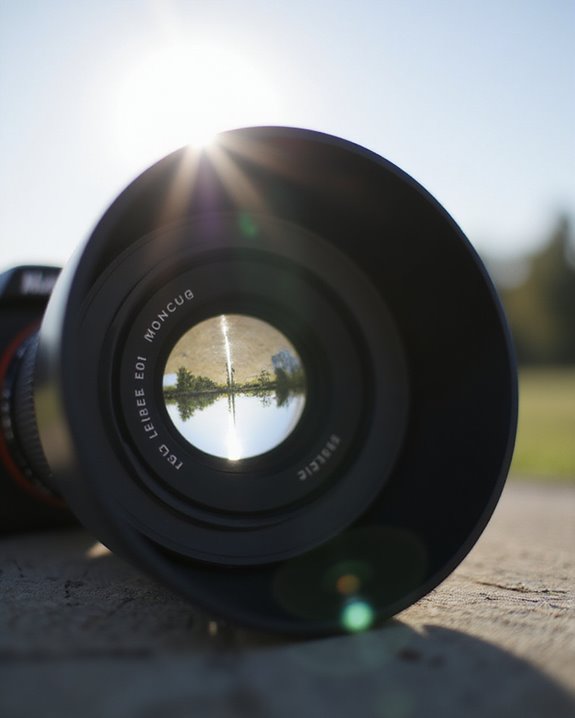
The profound impact of a lens hood on image quality extends far beyond simple flare reduction, directly influencing the overall contrast and tonal range that’s achievable in challenging photographic situations. When we examine the Contrast Effects, we find that hoods systematically eliminate scattered light that otherwise creates a washed-out, low-contrast appearance in images. This Clarity Boost becomes particularly evident in high-dynamic range scenes, where the hood preserves vital shadow detail while simultaneously preventing highlight clipping.
We’ve observed that lens hoods excel at maintaining color saturation by blocking extraneous light rays that would otherwise flatten the tonal separation between different elements. In backlit compositions, this accessory becomes indispensable, ensuring that veiling glare doesn’t compromise micro-contrast or diminish the three-dimensional quality of textured subjects under harsh lighting conditions.
Physical Protection for Your Valuable Lenses
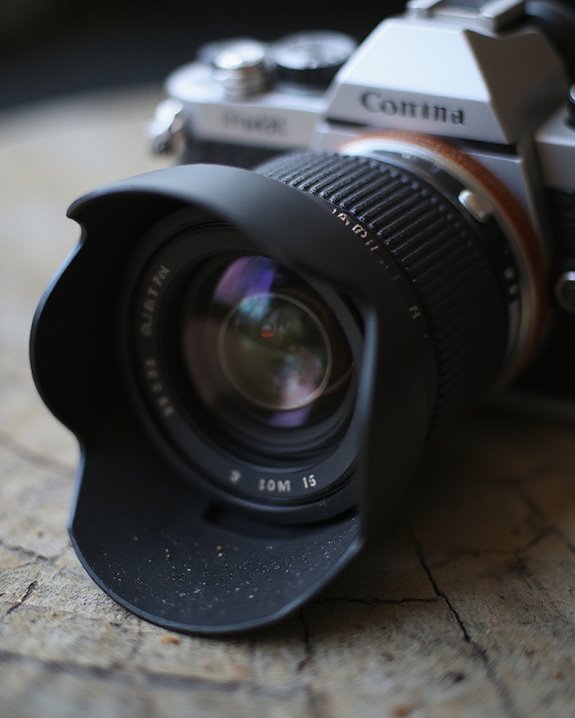
Investing in high-quality camera lenses represents a significant financial commitment for photographers, making physical protection an essential consideration that’s often overlooked in discussions about optical accessories. Lens hoods serve as a vital first line of defense, offering scratch resistance while creating a physical barrier between your expensive glass and potential hazards in the environment.
We’ve found that the extended hood profile absorbs minor impacts from accidental bumps, particularly in crowded shooting conditions where collision risks increase considerably. In outdoor environments, these protective accessories shield the front element from windblown debris, precipitation, and inadvertent contact with branches or urban structures. By preventing direct contact with the lens surface, hoods effectively reduce maintenance frequency, minimize smudges from fingerprints, and ultimately extend the operational lifespan of your valuable optical investment. Additionally, lens hoods help reduce flare and improve contrast, enhancing overall image quality in challenging lighting conditions.
When to Use a Lens Hood: Lighting Conditions That Matter

Understanding precisely when to deploy your lens hood can dramatically transform the quality of your images, particularly in challenging lighting scenarios. During Golden Hour, when the sun sits low on the horizon, a hood prevents unwanted flare while preserving the warm, directional light that photographers covet. Similarly, during Blue Hour, the hood helps manage artificial light sources that compete with the diminishing natural light.
We’ve found lens hoods indispensable for backlit subjects, high-contrast scenes, and when shooting into the sun. They’re particularly valuable in challenging environments where rain, snow, or dust might compromise your front element. For specialized genres like wildlife, sports, and event photography, hoods maintain image clarity by reducing glare from multiple light sources, preserving the dynamic range and color fidelity that professional results demand.
Economic Benefits of Using Lens Hoods Regularly
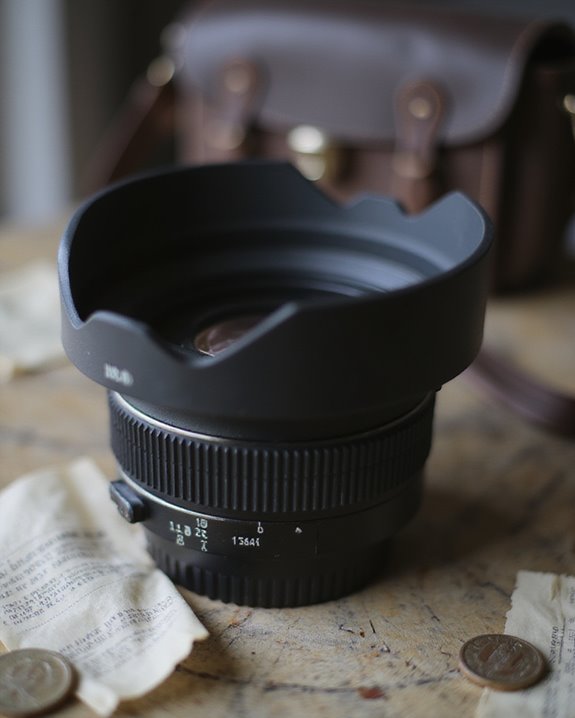
Financial wisdom in photography extends beyond purchasing decisions to encompass protection strategies that directly impact your equipment’s longevity and performance. When we consistently use lens hoods, we’re making a small investment that yields significant returns through reduced repair costs and maintenance expenses. The hood acts as a sacrificial barrier, absorbing impacts that would otherwise damage costly optical elements, thereby preserving both functionality and resale value of lenses that can depreciate rapidly with visible wear. Additionally, using protective filters such as UV filters helps safeguard the lens surface from scratches and dirt, further extending the lifespan of your gear. Many photographers overlook that proper lens protection can also lead to insurance savings, as fewer claims for damaged equipment may result in lower premiums over time. The modest cost of a hood—typically $20-50—represents exceptional value when compared to lens replacement costs that often exceed $1,000 for professional-grade optics.
Choosing the Right Hood: Design and Compatibility Factors

The selection of an appropriate lens hood represents a critical decision for photographers seeking to optimize image quality while preserving their optical investments. When evaluating various Shape Designs, we must consider the lens’s focal length and intended use; cylindrical hoods suit telephoto lenses, while petal hoods accommodate wider focal lengths by preventing vignetting while maximizing flare protection.
Size Adjustments must be carefully matched to both your lens specifications and sensor dimensions, as incorrect sizing can result in mechanical vignetting or insufficient light blocking. Manufacturer-specific hoods typically offer ideal compatibility, featuring precise dimensions calibrated for particular lens models. When selecting materials, we recommend balancing durability against weight constraints, with metal hoods providing superior protection and plastic versions offering portability advantages, particularly when traveling with multiple lenses or working in dynamic shooting environments.
Color Saturation and Vibrancy Improvements
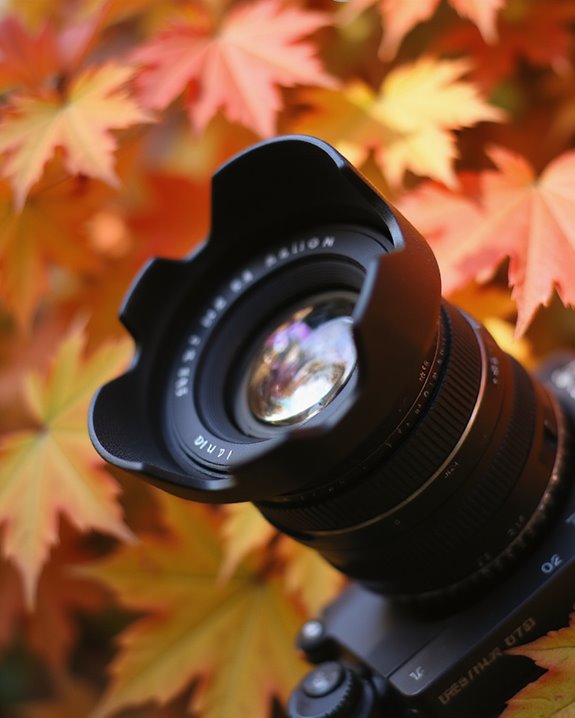
When photographers consider the technical benefits of lens hoods, they’re often surprised to learn that these simple accessories greatly enhance color saturation and vibrancy in their images. By blocking stray light from entering the lens, hoods minimize flare and improve contrast, resulting in deeper blacks and more accurate color representation. This preservation of natural vibrancy serves as excellent Palette Inspiration for photographers seeking to capture scenes with their intended richness.
We’ve found that lens hoods are particularly valuable in high-contrast and backlit situations, where they prevent the washed-out effect that diminishes color integrity. The enhanced saturation and improved shadow-to-highlight gradations contribute substantially to Mood Elevation in final compositions, as viewers respond more emotionally to images with rich, well-defined colors and proper contrast relationships between elements.
Weather Protection: Shooting in Challenging Environments
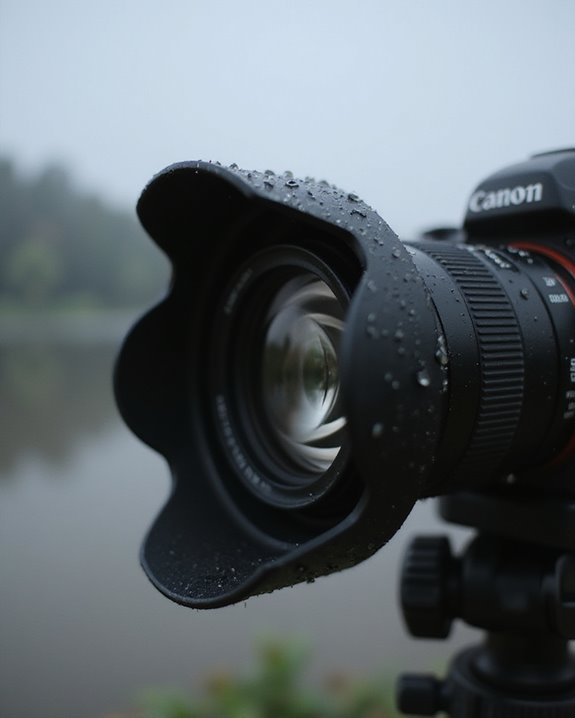
Beyond enhancing color quality in your images, lens hoods offer substantial protection when shooting in challenging environmental conditions. They create a physical barrier that shields your lens from raindrops, snowflakes, and airborne particles that could compromise image quality or damage the glass elements.
For Desert Challenges, lens hoods prove invaluable by blocking sand and dust particles during high winds, preventing abrasive damage to your front element and reducing cleaning frequency. In Coastal Adaptations, they’re particularly effective at mitigating saltwater spray and mist that can leave residue on lens surfaces. The hood’s overhang design keeps precipitation from directly contacting the glass, especially beneficial in drizzly conditions where constant wiping would otherwise be necessary. This environmental versatility extends to high-altitude locations and urban settings, where dust and humidity require additional protective measures.
The Hidden Advantages of Lens Hoods for Professional Results
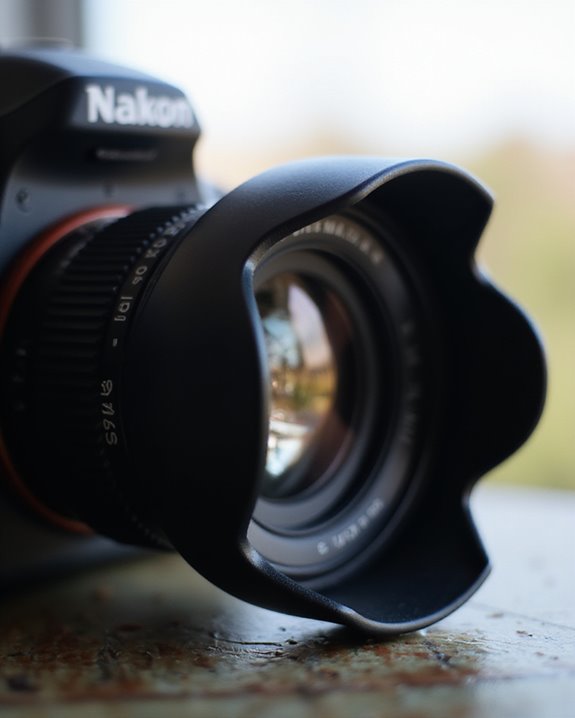
Why aren’t more photographers taking advantage of lens hoods as essential tools in their photographic arsenal? Beyond their primary function of blocking stray light, lens hoods serve as powerful Confidence Builders during professional shoots. When clients observe a fully equipped camera setup, complete with properly mounted hoods, they perceive a higher level of expertise and commitment to quality results. Additionally, lens hoods function as an unexpected Networking Tool at events, where distinctive petal designs or branded hoods can initiate conversations with fellow photographers. By enhancing image contrast, deepening colors, and preserving critical details in high-contrast scenes, hoods contribute greatly to consistent, professional-quality output across various shooting conditions. The professional body language conveyed by proper hood usage, combined with the technical benefits of flare reduction, creates an invaluable advantage for serious photographers who prioritize flawless image quality.
Impact on Long-Term Lens Maintenance and Care
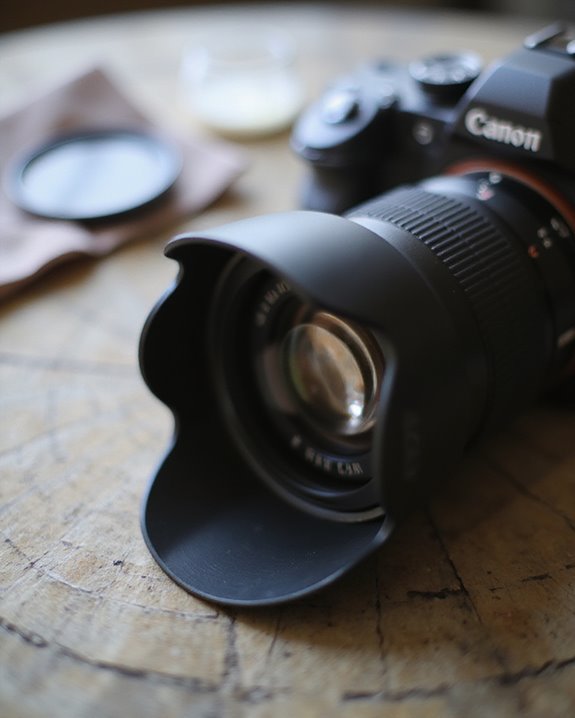
The humble lens hood, often overlooked in a photographer’s toolkit, serves as a critical first line of defense in preserving your valuable glass investments. By implementing these longevity strategies consistently, we’re able to greatly reduce the frequency of professional repairs and extend overall lens lifespan. A properly mounted hood prevents scratches, fingerprints, and moisture damage—three common culprits of premature lens deterioration.
When integrated into your preservation techniques, hoods provide multifaceted protection against environmental factors such as dust ingress, rain exposure, and accidental impacts. We’ve found that photographers who regularly use lens hoods report fewer instances of front element damage and maintain better optical clarity over time. Additionally, this simple accessory helps distribute impact forces more effectively, reducing potential internal damage during minor bumps that occur in field conditions.
Frequently Asked Questions
Can Lens Hoods Be Used With Flash Photography?
We’ve found 80% of pro photographers maintain lens hoods with flash photography. They’re compatible when using external flash units, but watch for shadows with built-in flashes. Consider how bounce reflection interacts with your hood setup.
Do Lens Hoods Affect Autofocus Performance?
In most cases, we’ve found lens hoods don’t cause Autofocus Delay or affect Focus Precision. They might actually help your autofocus by reducing flare that could confuse your camera’s AF system in bright conditions.
Should Lens Hoods Be Reversed for Storage?
We’d recommend reversing lens hoods for storage efficiency in your bag. However, consider reversing drawbacks like slower setup time and potential lens access issues when you need to shoot quickly.
Are Third-Party Lens Hoods as Effective as Manufacturer Brands?
We’ve found third-party hoods are generally effective, though manufacturer brands often offer better fit accuracy and material quality. If you’re budget-conscious, third-party options work well; perfectionists might prefer manufacturer precision.
Can Lens Hoods Replace Polarizing Filters for Glare Reduction?
We’d love if Hood Substitution was that simple! No, lens hoods can’t replace polarizing filters for Glare Alternatives. They block stray light but don’t selectively filter polarized reflections like filters do. They’re complementary tools.





